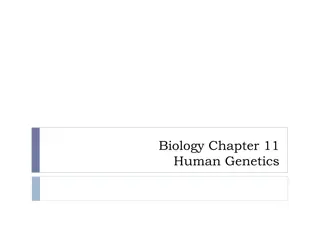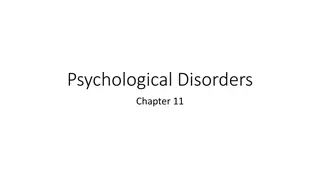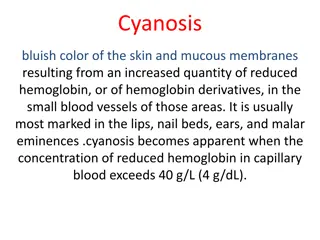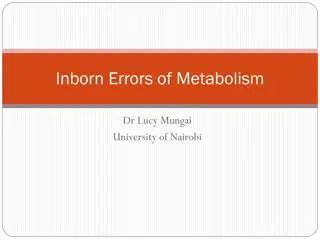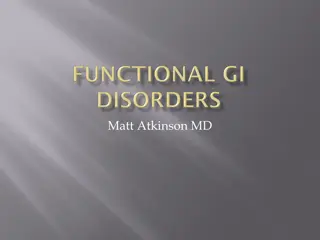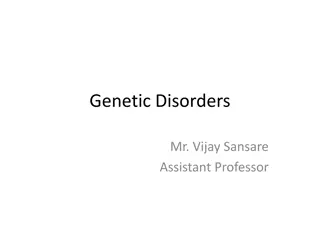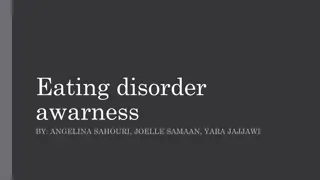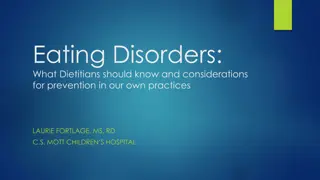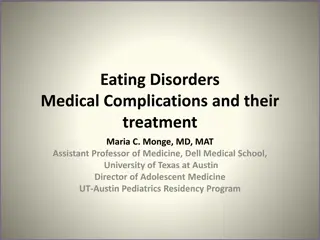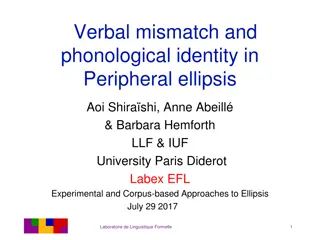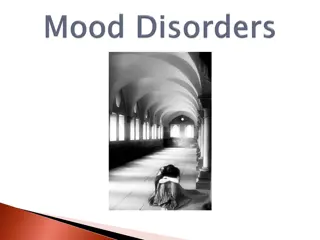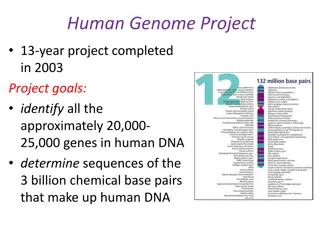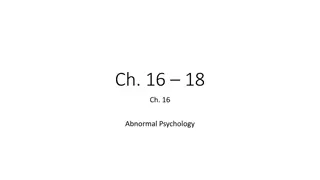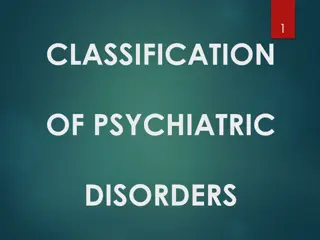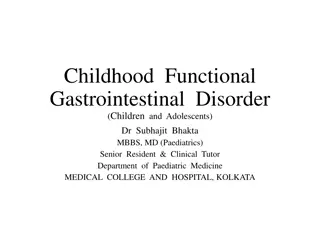Peripheral Neuropathies & Other Disorders
Peripheral Neuropathy is a condition affecting peripheral nerves, leading to sensory, motor, or autonomic nerve damage. It can manifest in various forms, including mononeuropathy, polyneuropathy, or multifocal neuropathy. Bell's Palsy, a type of mononeuropathy, is characterized by acute unilateral facial paralysis and is more common in certain populations. Clinical findings may include facial weakness, numbness, pain, and other symptoms. Treatment typically involves pharmacotherapy such as Prednisone and antiviral medication.
Download Presentation

Please find below an Image/Link to download the presentation.
The content on the website is provided AS IS for your information and personal use only. It may not be sold, licensed, or shared on other websites without obtaining consent from the author.If you encounter any issues during the download, it is possible that the publisher has removed the file from their server.
You are allowed to download the files provided on this website for personal or commercial use, subject to the condition that they are used lawfully. All files are the property of their respective owners.
The content on the website is provided AS IS for your information and personal use only. It may not be sold, licensed, or shared on other websites without obtaining consent from the author.
E N D
Presentation Transcript
Peripheral Peripheral Neuropathies & Other Neuropathies & Other Disorders Disorders dr. Yetty Hutahaean, Sp.S Kuliah Modul-3 Blok 15 Fakultas Kedokteran Universitas Mulawarman Rabu, 24 November 2022
Peripheral Neuropathy Peripheral Neuropathy Disease or injury of peripheral sensory, motor or autonomic nerves May be pure motor, pure sensory or mixed sensorimotor May occur as mononeuropathy, polyneuropathy or multifocal neuropathy
Bell Palsy Bell Palsy
General Consideration General Consideration Mononeuropathy Clinical syndrome of idiopathic acute unilateral facial paralysis Incidence 1: 5000 people More common during pregnancy & elderly
Clinical Findings Clinical Findings Unilateral facial weakness/facial drop, most around mouth forehead wrinkling & raising eyebrow, incomplete eyelid closure Patients may report exposure to cold preceded their symptpms Facial numbness or stiffness without objective sensory deficit
Clinical Findings Clinical Findings Mild-moderate pain at the angel of jaw May be loss of teste 2/3 ant tongue Decrease tearing and ipsilateral hyperacusis Not life-threatening functional, aesthetic & psycological consequences may have severe
Treatment Treatment Pharmacotherapy - Prednisone 1mg/kg/day for a week - Antiviral (still controversial): acyclovir 400mg,5x/day, 7-10 days if renal function is normal
Treatment Treatment Surgical Therapy: decompression as acute therapy based on hypotesis neuronal swelling within temporal bone invasive & risk permanent hearing loss highly Suportive Care - Artificial tears & ophthalmic ointment - Glasses or google
Prognosis Prognosis 60 - 80% cases months without treatment complete recovery in 1-2 90% achieve complete recovery with corticosteroid 5% cases permanent sequele During recovery period, may experience involuntary activation of facial muscle in ipsilateral region as a result of aberrant reinnervation (synkinesias & crocodile tear)
Carpal CarpalTunnel Tunnel
General Consideration General Consideration Mononeuropathy Carpal tunnel, formed by carpal bones & coverd ventrally by flexor retinaculum Prone to compression with repetitive flexion & extension Most common occupational diseases
Clinical Findings Clinical Findings Pain, paresthesias or numbness in the first 3 digits Worsen w/ repetitive/sustained wrist flexion or extension Intermittent constant Severe condition: hand weakness thenar flattening
Clinical Findings Clinical Findings Tinel & Phalen test (+) Medical condition that may increase risk: diabetes mellitus, hypothyroidism, pregnancy, rheumatoid arthritis, obesity
Diagnostic Studies Diagnostic Studies Electromyography & nerve conduction studies Motor & sensory conduction time through the carpal tunnel amplitudes : worrisome sign loss motor Blood studies to asses for the risk factor mention above
Treatment Treatment Pharmacotherapy - anti-inflammatory agents - Vitamin B6 - Short course of oral prednisone - local corticosteroid injection
Treatment Treatment Conservative therapy: wrist splinting in netral position at night & during activities Surgical: carpal tunnel release surgery transection of the transverse carpal ligament excellent success w/ few complication
Tarsal TarsalTunnel Tunnel
Guillain Guillain- -Barre Barre
General Consideration General Consideration Acquired polyneuropathy Group of immune-mediated disorders Annual incidence 1-2 cases per 100.000 people Most common form: acute inflammatory demyelinating polyradiculoneuropathy (AIDP)
General Consideration General Consideration Progressive weakness of extremities w/ attenuation or loss of reflexes Target antigen susp on myelin sheat Patologically, demyelination begin in the proximal nerves distal
General Consideration General Consideration Upper respiratory infection, gastrointestinal infection or non specific febrile illness, precedes neurologic symptoms Campylobacter jejuni: most frequently identified organism
General Consideration General Consideration Subtypes: 1. Acute inflammatory demyelinating polyradikuloneuropathy (AIDP) 2. Acute motor axonal neuropathy (AMAN) 3. Acute motor sensory axonal neuropathy (AMSAN) 4. Miller fisher syndorme
Clinical Findings Clinical Findings Often begins 1-3 weeks after infection 70% patients initially have parestesias or numbness in hands & feet weakness (typically ascending) progress days weeks symmetris Paralysis max about 2 weeks (50%) & 1 month in > 90% pts.
Clinical Findings Clinical Findings Respiratory paralysis may rapidly appear ( AIDP) necessitating intubation & mechanical ventilation Autonomic nervous system involvement: dangerous fluctuation od blood pressure or cardiac arrythmia
Clinical Findings Clinical Findings Examination: - symmetric flaccid weakness - normal sensation, despite sensory symptom - impending respiratory failure - autonomic involvement: cardiac arrythmia, BP fluctuation, flushing, sweating, abnormal GI motility
Diagnostic Studies Diagnostic Studies Lumbal puncture: - CSF protein few days after onset, peak in 4-6 weaks - cell count normal/ mild lymphocytic pleocytosis cyto-albumin dissociation Nerve conduction studies EMG : motor unit recruitment
Treatment Treatment Intravenous immunoglobulin: IVIG 0,4 g/kg/day for 5 days Plasmapheresis: 5-6 exchanges over 1-2 weeks Combination of both gives no additional benefit Randomized trials of oral & intravenous corticosteroid: failed to show benefit
Prognosis Prognosis Most patients return to normal function After progression stops, symptoms usually plateu for 2-4 weeks recovery gradual 20-25% require mechanical ventilation 5% die
Prognosis Prognosis Residual motor weakness in 25% after 1 year Poor prognostic factors: Older age, ventilatory support, rapid progression (<7 days), low motor amplitude probability of walkin independently at 6 months < 20%
Myasthenia Myasthenia
General Consideration General Consideration Most common of neuromuscular junction disordes Acquired, predominantly antibody mediated autoimmune disease Antibodies targeted against nicotinic acetylcholine receptor (AChR) Prevalence 1: 10.000-20.000 people Comorbid thyroid disease (> 10%)
Clinical Findings Clinical Findings Fluctuating, fatigable weakness of commonly used muscles Hallmark features: ptosis, diplopia, disarthria, dysphagia, respiratory & limb muscles weakness Half of patients present w/ ocular findings, usually bilateral, asymmetric
Clinical Findings Clinical Findings Myasthenia crisis: respiratory symptoms in conjunction with severe bulbar symptom (15-20% patients) mechanical ventilation Risk pregnant women during first trimester, improve during second & third trimester
Diagnostic Studies Diagnostic Studies Tensilon (edrophonium) test: 1mg iv 3mg iv (3x) Observe respon in 30-60 (negative if no response until 2 ) Laboratory studies: - AChR binding antibody - AChR modulating antibody Electrodiagnostic studies Asses the present of tymoma by chest CT-Scan/MRI
Treatment Treatment Symptomatic treatment - Acetycholinesterase inhibitor (pyridostigmin, at least 3-4x daily) Immunosupressive treatment - Thymectomy - Medical therapy: corticosteroid - Plasmapheresis - IVIG
Prognosis Prognosis 80% general myasthenic Cholinesterase inhibitor, low- dosecorticosteroid may control symptom Patients w/ thymoma aggressive disease course more
Radiculopathy Radiculopathy
Cauda CaudaEquina Equina
Brachial Brachial
Thank you Thank you


